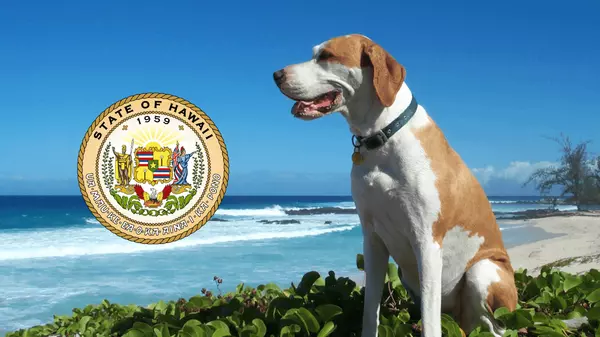Hawaii Pet Quarantine Information
Hawai‘i is the only state in the U.S. that is completely rabies-free—a distinction it has proudly maintained thanks to decades of strict animal import regulations. While the process of bringing pets into the state can feel complex or inconvenient, these protocols are in place to protect the health and safety of Hawai‘i’s people, pets, and native wildlife. Understanding the requirements and planning ahead is essential for ensuring a smooth transition for both you and your furry companions.
~ 18,000
PETS GO THROUGH HAWAII QUARANTINE EVERY YEAR
~ 90%
CATS & DOGS QUALIFIED FOR DIRECT AIRPORT RELEASE

It's a Process,
BUT DEFINITELY WORTH THE JOURNEY.
Relocating with pets to the Big Island adds a few extra steps, especially since O‘ahu is the designated Port of Entry for all arriving animals. That means your pet must first arrive in Honolulu, even if your final destination is another island.
From navigating the "5-Day-or-Less" or Direct Airport Release program to coordinating inter-island transfers, there's a lot to manage—but with the right guidance and preparation, it’s absolutely doable. This page will walk you through the essential steps, resources, and tips to make moving to Hawai‘i with pets as stress-free as possible.
I’ve personally been through the process—bringing two large dogs with me from Colorado back when the rules were even more complex—so I understand the challenges firsthand and am here to help make it easier for you.
Hawaii Pet Quarantine FAQ
Yes, you can bring your pet to Hawaii, but due to the state’s strict rabies-free status, specific protocols are in place. Most dogs and cats must qualify for the “Direct Airport Release” or “5-Day-or-Less” quarantine program. Without meeting all pre-arrival requirements, pets may be subject to a quarantine period of up to 120 days.
Quarantine Program Options:
Direct Airport Release (DAR)
If all pre-arrival conditions are met and your pet is flying into Honolulu International Airport (HNL), they may be eligible for same-day release at the airport.
5-Day-or-Less Quarantine
Pets that meet most—but not all—DAR criteria may qualify for a short stay at the quarantine facility in Honolulu before being released to you.
120-Day Quarantine
Pets that do not meet the required vaccination or documentation timelines must be quarantined for up to 120 days at the State Animal Quarantine Station on Oahu.
Steps to Qualify for Direct Airport Release or 5-Day-or-Less:
- Your pet must have a scannable microchip.
- Two rabies vaccinations are required, administered at least 30 days apart, with the most recent shot given at least 30 days prior toarrival.
- A FAVN rabies blood test must be completed with a passing score of 0.5 IU/ml or greater.
- You must wait 30 days from the date of the FAVN test result before arriving in Hawaii.
- Submit the required AQS-279 Dog & Cat Import Form and payment at least 10 days prior to arrival.
- Obtain a health certificate from a licensed vet within 14 days of travel.
- Administer approved flea/tick treatment within 14 days of arrival.
- If flying directly to Kona (KOA), you must apply for a Neighbor Island Inspection Permit (NIIP) in advance.
Travel Tips:
- Begin the process 4-5 months before your move to ensure all vaccinations and tests are completed on time.
- Only certain airlines are approved to fly pets directly to neighboring islands, such asthe Big Island.
- Airline policies vary—check directly with your carrier (e.g., Hawaiian Airlines, Alaska Airlines) for in-cabin vs. cargo rules.
Important Note:
Pets that do not arrive with complete and accurate documentation will automatically be transferred to the 120-day quarantine program in Honolulu, at the owner's expense.
Helpful Resources:
Hawaii is the only U.S. state that is rabies-free, and to maintain that status, it enforces strict animal quarantine laws. The process varies based on whether your pet meets the eligibility requirements for expedited release.
Three Quarantine Program Options:
1.) Direct Airport Release (DAR):
Pets that meet all pre-arrival requirements (including vaccinations, rabies titer test, microchip, health certificate, and approved travel timing) may be released the same day they arrive—if flying into Honolulu with prior approval.
2.) 5-Day-or-Less Program:
Pets that meet most—but not all—DAR criteria are held briefly at the Honolulu quarantine station, then released within five days.
3.) 120-Day Quarantine:
Pets that fail to meet Hawaii’s pre-arrival requirements (such as missing or mistimed vaccinations or tests) are required to complete a full 120-day stay at the quarantine facility on Oahu.
All pets entering Hawaii must arrive with proper documentation and clearance. If even one step is incomplete or mistimed, the full 120-day quarantine will apply automatically—at the owner’s expense.
Helpful Resources:
- Hawaii Department of Agriculture – Quarantine Overview
- Contact Penn for Local Tips on Relocating with Pets »
You should begin preparing to bring your pet to Hawaii at least 4 to 6 months before your move. This allows enough time to complete all vaccination requirements, testing, and paperwork necessary to qualify for Direct Airport Release or the 5-Day-or-Less Quarantine program.
Recommended Timeline:
4–6 Months Before Arrival:
- Schedule a vet appointment to discuss Hawaii’s requirements.
- Implant a microchip if your pet doesn’t already have one.
- Administer the first of two required rabies vaccinations, if needed.
- Begin reviewing the 5-Day-or-Less Checklist.
3–4 Months Before Arrival:
- Administer the second rabies vaccination (must be at least 30 days after the first).
- Schedule the FAVN rabies antibody test—your pet must wait 30 days after the sample is received at the lab before arriving in Hawaii.
1–2 Months Before Arrival:
- Submit your AQS-279 import form, payment, and documents to the Hawaii Department of Agriculture.
- Apply for the Neighbor Island Inspection Permit (NIIP) if flying directly to Kona or another approved neighbor island.
- Arrange your flight with a pet-approved airline.
2 Weeks Before Arrival:
- Obtain a health certificate from your veterinarian (must be dated within 14 days of travel).
- Administer a tick/flea treatment within 14 days of arrival.
Helpful Resources:
- Hawaii Animal Quarantine Timeline & FAQs
- Checklist for Dog & Cat Import
- Contact Penn for Moving Support & Pet-Ready Neighborhoods »
Yes, but not all Hawaii airports accept direct pet arrivals under the state’s quarantine program. The primary approved airport for processing pets is Daniel K. Inouye International Airport (HNL) in Honolulu. However, with advanced approval, pets may also arrive directly at select neighbor island airports under specific conditions.
Approved Airports for Pet Entry:
1.) Honolulu (HNL) – Primary quarantine processing location
- All pets arriving in Hawaii without prior approval must enter through HNL.
- Direct Airport Release and 5-Day-or-Less programs are processed at the Animal Quarantine Holding Facility in Honolulu.
2.) Kona (KOA), Kahului (OGG), and Līhu‘e (LIH) – Neighbor Island Entry with Permit
- Pets may fly directly to the Big Island, Maui, or Kaua‘i only if they meet all entry requirements and the owner obtains a Neighbor Island Inspection Permit (NIIP) in advance.
- An approved veterinarian must examine pets arriving at these airports upon arrival.
- These arrangements require close coordination and advance scheduling.
Important Notes:
- The Hawaii Department of Agriculture must approve the airline to fly pets directly to the neighbor islands.
- Pet owners arriving without a valid NIIP or incomplete documentation will have their pets transferred to the Honolulu facility and will be subject to full quarantine.
Helpful Resources:
- Neighbor Island Inspection Permit Information
- Contact Penn for Help Coordinating Pet-Friendly Arrivals »
To bring a pet into Hawaii and qualify for Direct Airport Release or the 5-Day-or-Less quarantine program, you must submit a complete and timely set of documents to the Hawaii Department of Agriculture (HDOA). Missing or incorrect paperwork can result in a 120-day quarantine at the owner’s expense.
Required Documents:
AQS-279 Dog & Cat Import Form
- Must be completed and submitted at least 10 days prior to arrival.
Download AQS-279 Form
Original Rabies Vaccination Certificates (2 doses)
- Certificates must include vaccine product name, lot number, dates, and the veterinarian’s signature. The most recent shot must be over 30 days old and administered no more than 12 months prior (or as specified by the product’s duration).
FAVN Rabies Antibody Test Results
- A passing result of 0.5 IU/ml or higher from an approved laboratory is required. Results must be submitted directly to the HDOA or included with your application.
Veterinary Health Certificate
- Issued within 14 days of arrival. It must state that the animal is healthy, has no external parasites, and is fit for air travel.
Tick and Flea Treatment Record
- Proof of approved treatment (e.g., fipronil or equivalent) administered within 14 days of travel.
Neighbor Island Inspection Permit (NIIP)
- Required if flying directly into Kona, Kahului, or Līhu‘e. It must be obtained at least 30 days in advance.
Apply for NIIP
Tips:
- Keep original documents with you while traveling—do not pack them in checked luggage.
- Make sure all documents use consistent names, microchip numbers, and dates.
- Allow extra time if your pet’s FAVN test is not processed through your veterinarian’s lab portal.
Helpful Resources:
- Hawaii Pet Import Forms and Instructions
- Contact Penn for Step-by-Step Guidance »
Yes, Hawaii requires payment for all pets entering the state under its quarantine programs. Fees vary based on the program your pet qualifies for and whether you’re arriving in Honolulu or through an approved neighbor island with a permit.
Current Quarantine Program Fees (as of 2025):
Direct Airport Release (DAR):
$185 per pet (must meet all eligibility requirements for same-day release at Honolulu)
5-Day-or-Less Quarantine:
$244 per pet
Neighbor Island Inspection Permit (NIIP):
$165 per pet (in addition to DAR or 5-Day-or-Less fees)
Required for pets arriving directly in Kona (KOA), Kahului (OGG), or Līhu‘e (LIH)
120-Day Quarantine:
$1,080 per pet
Charged to owners whose pets do not meet Hawaii’s entry requirements and must complete full quarantine on Oahu.
Payment Instructions:
- Fees must be paid in advance by money order, cashier’s check, or certified check, made payable to the Hawaii Department of Agriculture.
- Include your payment with the completed AQS-279 Import Form.
- If applying for the NIIP, allow at least 30 days for processing.
Helpful Resources:
- Hawaii Animal Quarantine – Fees & Forms
- Contact Penn for Relocation and Pet Travel Help »
No, emotional support animals (ESAs) are not exempt from Hawaii’s animal import and quarantine requirements. Whether your pet is a companion animal, therapy animal, or ESA, it must comply with all pre-arrival protocols, including vaccinations, microchipping, rabies testing, and quarantine processing.
Key Points to Know:
- ESAs are treated the same as household pets under the Hawaii Department of Agriculture (HDOA) rules.
- To qualify for Direct Airport Release or 5-Day-or-Less quarantine, all standard requirements must be met, regardless of ESA status.
- Documentation of emotional support need (such as a letter from a healthcare provider) does not alter the pet import process or waive any fees.
Service Animals Exception:
Only properly trained service animals (e.g., guide dogs for the visually impaired) may qualify for modified handling, but they must still meet all health and documentation requirements. Owners must submit additional service animal forms and follow specific protocols outlined by HDOA.
Helpful Resources:
Yes, there are many opportunities to adopt or foster pets on the Big Island after you relocate. Local shelters, humane societies, and rescue organizations are always in need of responsible residents willing to provide loving homes, either permanently or temporarily.
Adoption Options on the Big Island:
Hawai‘i Island Humane Society (HIHS):
The largest and most active shelter on the island, with locations in Kona, Kea‘au, and Waimea. Offers cat, dog, and small animal adoptions, as well as fostering programs.
Visit HIHS →
Aloha Ilio Rescue:
A foster-based dog rescue located in West Hawaii, focused on rehoming abandoned or neglected dogs.
Visit Aloha Ilio →
Fostering Opportunities:
- Many organizations offer short- or long-term foster options for pets awaiting adoption or transport.
- Fostering is a great way to support the local community and help animals without a long-term commitment.
- Supplies, food, and medical care are often provided by the organization.
Tips:
- If you're renting, verify pet policies before applying to adopt or foster.
- Some programs may require a home visit or references.
- Volunteering is another great way to get involved if you’re not ready to adopt right away.
Helpful Resources:
Yes, but bringing birds, reptiles, or exotic animals to Hawaii is highly regulated and requires advance approval from the Hawaii Department of Agriculture (HDOA). Unlike cats and dogs, these animals are subject to additional import restrictions, permitting requirements, and in some cases, outright bans to protect Hawaii’s delicate ecosystem.
Birds:
- Most birds require an import permit from the HDOA before arrival.
- Certain species are prohibited entirely due to the risk of avian diseases or ecological disruption.
- Birds may also be subject to quarantine periods at a designated facility.
- USDA health certificates and testing for psittacosis and Newcastle disease may be required.
- View Hawaii Bird Import Info
Reptiles & Amphibians:
- Hawaii has strict laws prohibiting the import of most reptiles and amphibians.
- Common pets like snakes, iguanas, and geckos are illegal to possess or import.
- Some exceptions exist for scientific or educational institutions with special permits.
- Hawaii Prohibited Animals List
Exotic Mammals & Invertebrates:
- Animals like ferrets, hamsters, gerbils, and certain exotic mammals are restricted or banned.
- Importing exotic pets without a permit is considered a felony offense in Hawaii.
How to Apply:
- Contact the HDOA Plant Quarantine Branch for pre-approval before making any arrangements.
- Never attempt to bring a restricted species into Hawaii without proper permits—it can result in confiscation, fines, or criminal charges.
Helpful Resources:
The most accurate and up-to-date information about bringing pets to Hawaii comes directly from the Hawaii Department of Agriculture (HDOA). Whether you’re moving with a dog, cat, bird, or other animal, the HDOA outlines the full set of requirements, forms, and timelines needed to comply with the state’s strict import laws.
Official Resources:
HDOA Animal Quarantine Program (AQS):
- Main Pet Import Information Page
This is your starting point for forms, quarantine rules, approved airports, timelines, and program checklists.
5-Day-or-Less Checklist (Dogs & Cats):
- Download PDF Checklist (PDF)
Use this guide to meet the requirements for expedited release or short-stay quarantine.
AQS-279 Dog & Cat Import Form:
- Download AQS-279 Form (PDF)
Required for all dog and cat entries to Hawaii, submitted at least 10 days before arrival.
Neighbor Island Inspection Permit (NIIP):
Other Animal Import Info:
Additional Help:
- If you’re unsure which program applies to your pet or need help navigating the process, a local veterinarian familiar with Hawaii's import requirements can be a valuable resource.
- For community-specific insights and relocation support, contact Penn »While it’s possible to purchase a condo without a buyer’s agent, having professional representation is highly recommended—especially in Hawaii, where real estate laws, ownership structures, and condo-specific rules differ from the mainland.
Why Work with a Local Agent:
Understanding Leasehold vs. Fee Simple:
A local agent can help you avoid surprises by explaining the legal and financial differences between these two ownership types, which are more common in Hawaii than elsewhere.
Guidance on HOA Rules, Fees & Restrictions:
Your agent will help you review pet policies, vacation rental rules, reserve funding, and other important details before submitting an offer.
Expert Navigation of Local Escrow & Title Process:
Hawaii’s real estate system has unique steps, timelines, and regional customs. A knowledgeable agent ensures nothing is overlooked.
Access to Off-Market & Upcoming Listings:
Many luxury and investment properties are not publicly listed. Agents often have insider access to these opportunities.
Contract Negotiation & Due Diligence:
Your agent works to protect your interests, helps coordinate inspections, reviews condo documents, and ensures key deadlines are met.
Helpful Resources:
Helpful Resources
BRINGING PETS TO HAWAII

State of Hawaii Quarantine Info
Learn about Hawaii’s pet import requirements, quarantine programs, and how to prepare your pet for a smooth arrival. This official site provides step-by-step guidance, forms, and timelines for the process.

Makani Pet Services
Offering clients and those relocating to the island the option to have their pets released directly to them after meeting all the state's requirements upon arrival at Kona International Airport in Kailua Kona, Hawaii.

Search Big Island Homes
Start exploring current listings of homes and condos across the island to get a feel for prices, neighborhoods, and what fits your lifestyle. It’s a great first step toward making your move a reality. Be sure to contact Penn for additional guidance.

Pet-Friendly Condos
I can help you navigate the ins and outs of each community, including which condos have pet-friendly policies. Whether you're moving with a dog, cat, or both, I’ll find the right properties that align with your lifestyle and your pets' needs.

